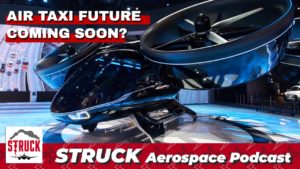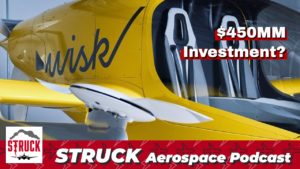The United States Senate released their scathing report on Boeing – but was it justified? Allen weighs in on the blame Boeing continues to take and whether or not Senate staffers should be named in these reports. Joby Aviation had its EVTOL design approved by the Air Force – is this a big deal? And, is hydrogen power– a la the HY4 aircraft that just completed a successful demonstration — gaining traction?
Learn more about Weather Guard StrikeTape segmented lightning diverter strips. Follow the show on YouTube, Twitter, Linkedin and visit us on the web. Have a question we can answer on the show? Email us!
Podcast: Play in new window | Download
EP41 Transcript – Hydrogen HY4 Aircraft Takes Flight; Joby Approved by USAF, and The Problem with the Senate Report on Boeing
Welcome back to the struck podcast. These episodes we’re going to cover in our first section, a bunch of stuff on Boeing. Obviously the Senate, uh, just released their big report, a rather scathing report on some FAA and Boeing. Perhaps improprieties. So we’ll talk a bunch about that today in our second segment about engineering, we’re going to chat about the H Y four a, which is a vehicle that just made its first flight over in Slovenia.
It’s a hydrogen fuel cell powered hybrid electric vehicle or aircraft. So we’ll talk about that in our section. Well, you’ve got a couple of good things, a little bit on Joby being approved by the air force, an update on and John air mobility, and also some interesting news about LA. Creating a partnership for urban air mobility to do some planning about how that might come about in Los Angeles.
So, Allen first thing here, obviously the Senate came out with a pretty big report and a very far reaching as well and wagging their fingers some more at Boeing who. Well, as we were just talking about off-camera I can’t stay, I can’t stay out of the news. Um, but this is raising questions about and propriety and reaction time and all this different stuff.
But, um, what are the key takeaways for you that are really raising eyebrows? Cause you know, there’s a bunch,
well, the report. Covers so much territory involving the FAA and some part Boeing, some part other airlines, uh, uh, not necessarily affiliated with Boeing and sense and Southwest airlines, because Southwest is a big user of.
Sevens obviously. Yeah, but it just seems like any time that there’s some issue involving the FAA, that didn’t go the way that a particularly employee wanted to go, that that ended up in this report. So it’s like, uh, uh, beans of kicking the FAA around, uh, from a congressional side and it did it. It doesn’t really have a point.
It’s just seems like there’s just a series of, uh, of, um, disgruntled employees slash, um, uh, maybe some poor performance on some, or maybe, maybe there are some employees looking the other way at the FAA for particular aspects, uh, that just get cumulated and, and. Stuck in a report and an issue to as how you look, how bad the FAA is.
That is not, uh, a valid exercise. It doesn’t help anybody. There’s there’s no one that’s going to read this and go, Oh yeah, well we need a correct ABC. That’s not, what’s going to happen here. And in fact, during some part of the report has to deal with, uh, uh, congressional subpoenas and employees of the FAA slash DOD department of transportation.
Not showing up for, or not responding to the subpoenas and maybe there’s some blackballing or, uh, obfuscation that’s going on here. That’s that is just that’s. First of all, it’s mind reading. And, and second of all, it’s not backed by facts. And so you would hope that a Senate report, would it be backed by a lot of facts?
And if you ever read a lot of center reports, you realize there’s just hardly any facts. And most of them that a lot of it is sort of a mind reading event, uh, put together by staffers. So there’s, there’s a lot, if you read through this report and it is extremely long and it lists all kinds of people. In it, uh, that it makes accusatory claims about a lot of people and their intentions.
Uh, but at the end of, at the end of it, it doesn’t say who wrote it. Right. It’s just you by the committee. Well, the committee is made of people and this mostly probably made a staffers and the staffers wrote this report. There’s no Senator or sat down and type any part of this thing. So who are the staffers who wrote this?
And why is their name not on it? Because if we were willing to call out an FAA employee, or are you willing to call out an airline employee, are you willing to call out a DOD employee or anybody else? Then you got to put your name at the bottom of it. And. And pony up because if you’re gonna accuse somebody have some sort of malfeasance or cause of the death of others and you better, better put your name to the bottom of it and explain, explain yourself, right?
Because you know, Senate, the Senate and the Congress, um, exclude themselves from lawsuits so they can write whatever they want. And no one gets to say about it. Right. So you’re defenseless. So you’re really kicking a defenseless person and that’s not the way the American system is supposed to be set up.
Right. You can make an accusation and then the person can say, Hey, you know, that’s, that’s slander, let’s go to court and find out you can’t do that. He gets Congress. They can write whatever they want. So in a sense, you can’t punch back. There’s no way the FAA is going to punch back. How, how, how, how are they going to do that?
Right. And some, and some part of this is like, uh, a Boeing employee told us. Flight test pilot to when they’re going to often sort of do a, what I would consider to be like a demo flight on the updated M cast system. Make sure you turn off the horizontal stab switch, uh, quickly. Okay. Fine. But what does that have to do with anything?
Did it have anything to do with the recertification of that system? No. Evidently not. Uh, did it affect safety any matter? Obviously not because that system has been approved now by the FAA and Yassa and everybody else in the world for the most part. So what’s the accusation. That’s just some sort of impropriety by this one employee.
Maybe it’s an extra or mind reading into this one person in his head. Who knows why he, or she said it. Who knows? I don’t know, but why is it in the report?
Yeah, and I don’t, obviously I’ve never been an airplane, uh, simulator, but it says here that, you know, some pilots were told to, you know, get right on that pickle switch, um, to help the reaction time.
In the simulator. So when they kind of gave them that coaching, it would get them down to below the, hopefully below the four second threshold that they established. Right. Pilots that were not given that typically reacted in 16 seconds. And so it’s, uh, this article from airways, uh, areas, mag.com is saying that that clearly demonstrate how tests were manipulated.
But like you said, if that’s just part of it, I mean, Can’t you be in the simulator and just be learning and someone, I mean, isn’t coaching someone part of the learning process. I mean, is, is it meant to be when you’re in the stimulator, just do it and fail or don’t I don’t think, and I’m not speaking from any copy experience whatsoever, so I don’t know.
Well, do you think there’s a reasonable chance that this employee, uh, did it so that the aircraft get it certified, uh, knowing that there was going to be crashes involved in the future? Is that, is that what the, what they’re implying here? Because I think that’s what they are implying. I think they’re saying that the employee wanted to coach these pilots because the system was unsafe.
So they went so Boeing as a company was trying to push on them. Yeah. It’s like system.
I get what you’re saying. Yeah, you’re right. That’s just guessing as to whether there is mal-intent and I think right. What’s what’s the common saying that, you know, you should first assign and competence to something before you, you know, assign malice to it.
Like, why would you assume this person is doing it to cover up a scandal? When you could say to, they just like, maybe bad at their job and they’re just not doing, you know, they just. Should not coaching them and they just, or they just want them to, Hey, I want this pilot to pass this test. So I’m going to give him a little coaching rather than I want to give this test or this pilot coaching so that it covers up a huge problem that we have, like, yeah, it’s, that’s a fundamental difference.
And like you said, it’s trying to read the mind of the person who was giving the coaching itself.
And there’s no context to the comment, right? It’s, it’s completely taken out of context. It’s it’s, it’s hearsay. Really. It means somebody. It’s heard second hand also. So you don’t know what the conversation was before the conversation after was, you know, any context in that conversation at all, but yet somehow it’s, it appears to be being, uh, reported that it’s some sort of Boeing conspiracy.
And I find that that’d be one of the dumbest takes I’ve ever heard. If there’s there’s one thing that Boeing does not want is to have an unsafe system. They didn’t want to have an unsafe system. Three four years ago, whenever the in-car system was developed, there was no intent to make it an unsafe system.
There’s no financial benefit to anybody to do that. They’re there. Boeing makes $0 on crashes. It costs them a fortune, and clearly they know that and they knew that years ago. So I, this sort of after the fact. Malarkey that goes on is just ridiculous, especially in particular to the pilot reaction time and that little aspect to it, which is, I think is a valid concern of the PA the pilot reaction time to certain things that happen.
The cockpit is always a disputed subject. I’ve been in those meetings. I’ve heard those comments, it goes back and forth. And flight test pilots will say one thing. Engineers will say another. There’s a, just a general disagreement about it, but there were reports written. Year ago, more than a year ago by broad agencies, uh, like multiple, uh, um, of certification agencies around the world, talking about pilot response time.
That was a year ago. So this congressional, the Senate report comes out now and says, Oh, they got this new controversy about pilot reaction times that what’s not new to everybody in the FAA knew everybody in the world. And the certification authorities knew it was an issue. PI response time is a big certification you should, because.
How much that determines whether a system meets the requirements or doesn’t meet the requirements. If you can give a pilot 15 minutes to react or a certain scenario, you’re probably going to crash the airplane. If you give them one second is probably not enough time. Right? So where’s that happy, happy, medium at.
And what is the requirements for training time for pilots and how does that correspond to safety? That’s the argument everybody’s making now and that’s, that’s an ongoing, it continues to be an ongoing discussion. But I wouldn’t apply malintent to it. That discussion is, is always valid. And I think the certification authorities around the world said it a year ago, more than a year ago saying, Hey, we need to take a look at this.
And the particular aspect of a flight control system. What is longer pilot times reaction times mean in terms of the complexity and the safety of that system? I said, that’s a valid thing to think about. But what’s in the center report is just inflammatory and it’s just the Congress. The Congress put one out a couple of months ago, basically the same thing.
And there’s just not helpful. And I it’s it when you, when we’re in sort of this COVID environment and you see Congress flailing around, particularly now where they’re talking about, uh, try to kick the economy into gear. It has been going on for months, you know, and both sides are fighting, fighting, fighting, and you’re just thinking.
Why is nothing in Congress ever make any sense. And this was one of those things that just doesn’t make any sense,
right.
In our engineering segment today, we’re going to talk about hydrogen power. So the H Y four, um, is a. Hydrogen fuel cell powered aircraft and that’s, uh, coming out of a consortium called . So just an acronym for, I don’t know really why I can’t have an accent there, but it looked, I mean, it looked like it deserved that accident maybe, but modular approach to hybrid electric propulsion.
So we’ll leave that, uh, we’ll leave that in the shell. But, um, anyway, this consortium comprises, uh, pivotal, vertical solutions, compact dynamics, DLR H to fly and, and a number of others. Um, and they recently made a test flight, uh, in Slovenia and Alan you’re, I think a little impressed with this plane. Um, It’s got an interesting design.
It does look like one of the other Pippa stroll designs where it’s got the it’s pretty expansive and, um, looks real sleek. And, uh, it’s got dual cockpits. So what are some of the things that stick out to you about this? Uh, this H Y four.
Well, I, there’s a couple of really good videos online on YouTube that, that show the construction.
They must have done an interview in Slovenia with one of the local news, uh, services that kind of walks through the, the different aspects of the aircraft design. But essentially. Think of it this way. There’s, there’s a fuselage, there’s two fuselages, uh, sort of out outboard and in the center, there is, uh, uh, basically an engine pilot with a propeller on the front of it.
So the, the propellers in the middle of this assembly, it’s kinda like a P 38, but like backwards, somewhat, but, uh, The, the system is sorta is set up such that there’s at least on one side, there’s a hydrogen tank, a carbon fiber hydrogen tank, and one of the fuselages. And then in the center pile on where the engine is, there’s hydrogen to electricity, fuel cells.
And there was four of them, there, there, one in front of the other. And then at the very front of that pile on is an electric motor. Uh, batteries are installed in both fuselages and the sort of the left and right fuselage. So the configuration is very unique, uh, and they, I, I’m not even sure why they came up with this design besides you have a place to store the hydrogen fuel tank and the batteries.
Uh, but they, they described it as a four passenger airplane in it. For passenger would B it’s not airline configuration by any stretch or corporate aircraft configuration. You’re actually laying down this aircraft, like a glider. It’s very similar to a glider layout. So that’s what it looks like. A Burt Rutan design glider, advanced glider.
Uh, but the concept works right there. They’re flying it. Uh, it doesn’t look, I was watching them do some wiring inside the fuselage and like, Ooh, uh, it’s very home, home built. I w I w I want you to describe it like that because a lot of the home built Erik planning airplanes are very tight aerodynamics in terms of like aerospace quality.
Uh, this I wouldn’t say was right. There is more kit kit build home. Bill back backyard is short of. Set up, it had a flight displays in it and all kinds of electronics and things, but, um, it clearly was an experimental aircraft from, from that perspective and probably rightly so, but, uh, it is fascinating how much work is going into the hydrogen side, particularly in Europe because of the United States.
That’s like totally not hydrogen is it’s totally battery powered, which at some point those two are going to collide. Don’t you think that we’re going to run into the. Hydrogen battery powered clash of the Titans of some sort. At some point they have to write,
uh, yeah, I mean, it says here that the storage capacity is 10 to 21 kilograms of hydrogen.
Yeah. So, yeah, I guess just going to be simple math, whether, you know, 20 kilos of hydrogen or a battery with X capacity, which is more right.
Yeah. Hydrogen clearly has more energy density to it. Right. It can get you farther. And that’s why we’re starting to see, uh, the, what were originally designed as battery powered aircraft, going to some.
Sort of fuel cell technology, either being hydrogen powered or jet a fuel powered, uh, so that the jet fuels immediately convert into electricity through a little turbine, uh, which is sort of the way the Chevy volt Cora was done several years ago, where it had a gasoline turbine that create electricity, which power, the batteries and the wheels and the whole thing.
So it’s. Similar setup. Uh, you’re not using the, the fuel whatever fuel it is. As, as, as thrust, you just using this energy to spin a propeller, so electricity electric system. Um, but I, I think the really fascinating thing is. In Europe, where things are, tend to be closer together where batteries may make a little more sense.
They’re going to hydrogen in the United States, which is much more expansive and the cities are further and further apart are going to batteries. Won’t fly. They won’t fly as far. So
somewhere someone’s backwards,
backwards. Like someone needs to sit down with a pencil and a calculator and like, cause figure this thing out, right?
Because I can’t fly from Dallas, Houston. That’s a long ways and electric vehicle. I’m going to need something that. Burns of fuel. And if it is hydrogen fine, but you’re gonna need something of that sort because it just, you can’t do it. I mean, you could fly around Dallas and Dallas is big enough that you could, you probably want to hop from one side of the other with an electric vehicle, but you can’t do those longer runs.
And that’s where the problem is going to be, is trying to do the longer runs.
Well, that’s what I was gonna, I’ll ask you, uh, because obviously our third segments, so about why are none of these designs? Like, you know, Joby being the front runner, why are none of them featuring hydrogen? I mean, why, why is this model to seem to not be on anyone’s radar in the U S
well, I think let’s talk about Joby for a second.
So Joby at least to this point, and there’s not a lot of information coming out of Joby, but one of the things you do read is that they’re trying to be very efficient with the battery usage. They’re trying to get the range. Uh, extended as far as they can. So they’re trying to make the flight, the flight profile and the flight regime and the way they operate their aircraft to be as efficient as possible.
Uh, because hovering flight is extreme energy burn, any kind of helicopter flight is a extreme energy burn for batteries. So you want to get to four flight as fast as you can. And in fact, that’s what the Joby system is now doing. It’s just basically going straight to Florida for flight. Which is going to carry the maximum distance with the least amount of energy.
Uh, but I would almost bet that most of these systems don’t of these aircraft have a, have a means or provision to add a fuel cell technology to them. They would almost have to, because if you’re going to sell it in LA. Great. If you’re gonna, if you’re gonna sell it in a larger city like Miami or Orlando or someplace like that, you kind of need, and you’re going to say, and go to Orlando to Miami, right?
That’s a pretty common route. You’re going to need more energy than probably what most of these battery powered systems will deliver today. So there’s, there’s going to be a coming, uh, coming moment where they’re going to have to figure this out, but that’s one of the, that’s one of the things I’ve been watching for on all the designs is, is there a pod somewhere or the addition where they could put a pot on it, which could include hydrogen, coz I think, or jet a or some sort of fuel because that’s going to be key to have that versatility.
Yeah. Well, and the other thing that might. Um, make this more interesting in the future is that there’s been some recent announcements that Apple is going to enter the electric car space. And if Apple is just a second, really high powered company on battery technology, right then. You know, advances might be pushed even further.
So that obviously so much has changed and just urban transportation in general, whether it’s on the air or on land. Um, you know, you got to expect that it’s going to continue on that sort of, um, you know, exponential curve or battery tech in three years might be. Incredible and way beyond what we even think, especially with two big companies like that, working on it.
That’s a, that’s a really good question that you raised. Dan is, is with the recent, uh, battery day, a Tesla. There was an expectation on the engineering side, we’re going to see these massive improvements in battery technology, and that didn’t happen. No, no, no. There were some pretty significant changes to the way they’re going to manufacture batteries to make them less expensive and to increase their energy density.
But we didn’t see that sort of transformable transforming a presentation from Elon Musk, which. Then begs the question of is Tesla or Tesla and Apple now, and there’s a couple others weighing, weighing the battery versus fuel cell trade-off and all they’re going to get even more invested in like Tesla.
Are they going to get all the way involved in batteries or are they going to hedge their bets, like space X and all that burning fuel things are doing there. They’re going to hedge their bets with. An alternative fuel.
All right. So transitioning into our EBTL segment today, first thing on our docket here is some interesting news that Los Angeles has screening a partnership, uh, to advance urban air mobility, which is an interesting, uh, announcement. So basically they’re talking about. Developing a scalable system to support urban air mobility within LA.
Um, And so there are sort of one year plan and they said, this is a one-year project. And it’s going to, they’re going to map out challenges, implement solutions to challenges, visualize a Virta port, hire a UAM fellow to advance public engagement. And, uh, you know, it’ll have some financial support from, uh, Hyundai motor group, this all according to aviation today.
Right? So all those goals and things that they’re doing sound really. Nebulous and buzzwordy let’s find challenges and then solutions to those challenges. But it feels to me reading this, that like one year later, they probably won’t have done anything. Maybe I’m wrong. I don’t know, but that’s sort of how I, I read it, like, what are they actually going to do?
They’re going to, they’re going to draw, draw a Virta port visualize,
visualize a Virta port.
So we’re going to have a nice team of graphic designers make a Virta port on paper, and then like, this might be the future. That’s kind of what it felt like to me, it seemed real speculative, to be honest,
Dan, just starting to figure this thing out.
Yeah, no, I think you’re starting to figure this out, which is, it tends to be a lot of conferences and nice hotels and great meals and entertainment and campaign fundraising, which is what these eventually turned into. Because if there’s not a. Dedicated fixed list of things that will get accomplished.
Then what’s the point. And, and Los Angeles has, it has so many other problems right now that are way more massive than, uh, sort of the automobile highway infrastructure, because very few people are honestly are on the highway. So in Los Angeles right now, uh, and haven’t been down there for. Almost a year.
So is this the number one priority or is getting their economy going again and stopping some of the opioid deaths that are happening in Canada,
cleaning up skid skid row and terrible homeless problem. They have the
softball problems, right? And urban air mobility is not in the top 20. I would be, I wouldn’t listed in the top 100 for Los Angeles right now.
And. Why are they spending any time on it at all? It feels like, like we’ve seen on some, uh, more recent news is where the, some of these, uh, California legislators, mayors, whatever governors have been doing things that they’ve, uh, prohibited regular citizens from doing. So he kind of feels there’s that dichotomy of, Hey, I can hobnob with officials that may be able to right.
Checks to my campaign and everybody else has to eat cake. You know, it’s, it’s got that feel to it. I though the thing that I thought was fascinating about it, you didn’t see any of the, what I consider to be the real EVT, all companies involved in this at all to stand away from it. Yeah. Yeah. And that, that just kind of smells fishy to me.
It maybe a little of a warning flare, like, Hey, this is not on the, on the up and up or it’s going to accomplish anything that’s worth. Yeah. Wow.
Well, like we’ve discussed before this, at this point, it seems like this is way. Pulling the cart before the horse where there isn’t even a viable EVT oil yet.
Like again, like Joe Joby seems to be, have been like pulling ahead with their recent acquisition of Uber elevate and just, they’ve been seemingly raising lots and lots of money, which you’ve said as a necessity with certification, all that stuff. Sure. Uh, but like you’ve discussed before, Y Y visualize Virta ports when we don’t even know what the vehicle looks like and what it can do, like yeah.
You know, we’re going to draw them on the top of a building, but then is that even where these things are going to be capable of landing? Like, is that even a reality? It seems like this is all going to be driven by the aircraft. Like once we have the aircraft and what it can do and the, all the different ones, then you shape the environment that it’s going to.
Right. Like you wouldn’t build, you wouldn’t build a roads before you had a car. Right?
Like we didn’t that’s right. We didn’t
know, like, what do you let the car, let the car, make some, some ruts first and then go. Okay. What’s mega this wide and then this, you know, put some shoulders on it. And that seems like the logical progression.
And that’s what, that’s what happened in the United States. At least, right. There was our highway system didn’t really get going until after world war two. And there were, we were making cars and the. Tens twenties and thirties. This is a week, but we didn’t really have an interconnect to highway system to the 1950s.
It’s an it, the Eisenhower highway system is what they call it. Uh, yeah, that’s the way most things are developed. Right? You gotta have the, the, the, the mobile piece first and then all the infrastructure follows behind it because there’s a way to make a little bit of profit off of it. That’s going to be the same thing here.
Cause I think one of the interesting. Pieces to this is, which is say the vertical takeoff portion doesn’t work or is so energy intensive that you really can’t do it at shortens the range of these vehicles, uh, where you really can’t be efficient with them. So the next sort of the step down from that is short takeoff.
And landing, and I’ve seen some interesting, uh, news about some of the short takeoff and landing devices and aircraft that they may be maybe stepping into that role, that role. And so why would you design any infrastructure if you don’t have the vehicle design yet? Because you may need a slightly longer runway.
Right. You may need it.
Yeah. Well, and speaking of which, um, Joby aviation has been approved by the U S air force. And by Alan, this kind of raised an eyebrow with you, so said their prototype has been given, uh EBTL while airworthiness approval by the us air force as the part of their agility prime initiative.
This is an article from air mad air med and rescue.com. And, um, but there’s going to be further air worthiness approvals in the future. So is this distinct from the FAA? I mean, the air force can just have its own certification process. Right. Um, you know, w how does this article, like I said, it raised a little bit of an eyebrow from you.
I think it blurs the line between FAA certification and. Air force certification. They give it airworthiness approval and the FAA give it everywhere. That’s approval. I’ve read that. Or I’ve seen air force certification, those two words, those things conjoined. And that doesn’t seem like a real thing, right?
There’s only one level of certification in terms of you and I being on an airplane, which is FAA certification. That’s that’s the one in the United States. The air force. Quote, unquote airworthiness doesn’t mean anything besides that the air force is willing to evaluate the aircraft in terms of these applications to air force needs, but it sort of muddies the waters.
If you’re, if you’re an outsider looking into this aerospace world and you just read that the air force has approved it, you think, Oh man, and then I can go out and start ordering an airplane. That’s not a thing you can’t do that. The air force has no. Say in what the FAA does, uh, in terms of pivitol. So the whole thing is confusing and I understand there’s a, there’s an agility prime effort.
That’s going off to the air force, which is trying to encourage this electric vehicle. Technology to, to speed up, like if they can give us some funding. And th this is the beta technologies up in Vermont bit, is that they’re getting air force support to push the project had faster than they could otherwise, because investors right now are few and far between.
So it’s hard for those companies to exist without having some. Outside in this case, government, military support to push it along, but let’s make it absolutely clear that all these Evie tall aircraft are going to go through some level of FAA certification and it’s going to take years. Two three, four, probably five years to get certified.
And the air force announcement is something just directly related to the air force and, and that’s that.
Gotcha. Gotcha. So last on our list today, uh, John air mobility. And Verdugo arrow are going to be collaborating on a hybrid or electric VTL. So they’re going to use vertigo’s hybrid electric diesel, which burns Jedi.
Um, this seems interesting because you know, the John air is a. Gyrocopters that right?
Uh, in my world, that’s what I would call it. Yes. It’s good to see, it’s got this rotating blade above it, the booze, it rotates slowly. It’s not a helicopter. Uh, but it provides a lift thinking of it that way.
Yeah. And so, I mean, do you feel like more companies are going to go down this road where just to differentiate themselves, they might do a hybrid, um, you know, jet fuel electric, or we talked about the hydrogen electric.
Or is this a lot of weight to, this is going to add a lot of complexity to it. Um, and also my other question for you is how easy is it for companies just to partner like this? I mean the engineers butt heads a lot, is it? It seems like there’s like, it’s a difficult thing. I would imagine.
It’s really difficult.
Any two, if you try to, it’s like a matter and anti-matter on some level when you get near one another, there tends to be some sort of explosion happening. So the, the issue, when you, when you grab two engineering organizations that are not necessarily heading the same direction or, um, have different personalities and every organization has a personality, regardless of what.
Human resources will tell you there’s a, there’s a personality in those groups. And, and depending on what the leadership is, how well they’re going to play together. So, uh, you’ll, you will see, I’ll give you the power plant manufacturer versus air framers story. So regardless of who’s making the engines and who’s making the airframe.
There’s not a love relationship there and they rarely share a lot of data with one another. So if I’m building in myself, this brand new jet and I’m talking to, um, I don’t want to pick anybody out in particular, but as a, as a jet engine manufacturer, they will want to sell me a jet engine and it’s going to cost me a fortune to buy it.
But they’re not going to tell me a lot about it or how it’s designed. I can either take it or leave it. And that’s what tends to happen is there’s very little. Knowledge transfer that happens. And the engineering approaches will be different. No doubt. There are going to be different. So it’s a very difficult task to overcome that.
The only way that I’ve seen at work is if those two organizations become one. And they asked the people who don’t like to play in the sandbox to leave. That’s that’s the only way they come together. Because if you’re, if you’re not, uh, emotionally happy with the situation you’re in, because of this merger, any merger and your best bet is to get out.
And otherwise there’s no point. So when this, so when, when John John’s making the, John’s making the very conscious decision. Now because they haven’t developed an airplane, they don’t have an aircraft in put together that we’ve seen. We’ve only seen conceptual CAD models to speak of and pretty videos, but you would think that their architecture Joel should be heavy and complex.
You got this rotating wing over top when they got these electric propeller wing thing on the bottom, you would think that’s going to be relatively complex and heavy. Right. So someone’s must be sitting down. And saying we’re going to need X amount of energy to get per mile. If we want to really have a viable marketplace, we need to get to probably 200 miles be my guess.
Uh, and we can’t do that with batteries with the way this whole architecture system works. So we’re going to need. This other power plant system, this other energy system to feed the batteries and electric motors. And we better have that as an option because otherwise we’re not going to do it. So, so they’re making the decision early.
And this is what I was saying earlier that a lot of the other . Have a space for either a hydrogen tank or, or a jet, a tank or something to make electricity from, because you’re probably gonna need it to do the missions they need to in the United States and to have relatively high numbers of sales in the United States, they’re gonna need it.
Yeah. Well, I mean, and the one thing I think that. Maybe it hasn’t been addressed that probably should is that it seems like a lot of these EVT oil companies are going after the same distance, the same market, right? The short air taxi because of battery. So why not? Like, and I don’t know that the. Ultimate goal for John, but maybe they just want to go after a longer range, because again, you’re going to need maybe tears, like maybe Joby crushes it at the 50 mile range.
And another company is great at 150 mile range and someone else is great at 300 mile ranges. They have a hybrid. Right. We know that. Um, yeah. I’m going to, I’m going to blank on this one at the moment, but, um, you know, there’s a couple of companies that are just swapping in the hybrid electric engines for the purely.
Yeah, yeah. Right. You’re right. So it would just be all different sectors and maybe they’re, maybe they’re thinking, okay, we’ve got a spot that we could, we could fit into that other people aren’t coming for quite as much.
That’s that’s that? That’s all true. I, I, the, the issue revolves around and don’t.
Think aircraft is not a business. Aviation is a business and the only way to stay, keep the doors open is a cell product and the marketing and sales groups and all the surveys that are going on right now are looking at what is the potential marketplace for these products based on range. That’s that’s the argument.
And if, if the aircraft doesn’t go far enough, they won’t have enough sales. It won’t make enough money to keep the doors open. So what you’re going to see the United States was increasing range, uh, on those DVT Wells to make sales, to keep the doors open. That’s what’s going to happen.












